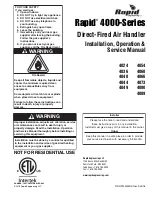
8
R2.060219
All rights to changes reserved.
www.swegon.com
2.2 Condensate discharge
As a rule, no condensate discharge connection
is needed under dry ambient conditions and in
combination with a rotary heat exchanger. A certain
humidity load exists in homes and a condensate
discharge line should be connected to the ventilation
unit, if considerable moisture is produced in the home.
Connect the discharge hose to the ventilation unit’s
condensate discharge connection (3/8” male threads).
The condensate must be channelled to a floor drain,
the water trap of a sink or the equivalent by means of
a tube or a pipe having an inner diameter of at least 12
mm. The tube must not be connected directly to the
sewer. The tube must not have a second water trap or
be run horizontally. The damming height of the water
trap should be at least 100 mm.
The condensate discharge connection is plugged
from the outside of the ventilation unit.
Remove
the plug when you begin using the condensate
discharge connection. Check that the condensate
discharge outlet is not clogged and check its outflow
by pouring water on the bottom of the ventilation unit.
The condensate discharge connection is located on the
rear of the unit under the rotary heat exchanger.
A hose to lead off the condensate is available as an
accessory (product: CDH3). The hose has a ready-made
loop that serves as a water trap.
200 mm
3/8" male
thread
There is a metal water trap available as an accessory
(UVL).
2.3 Ducts
Important
Check whether the ventilation unit is in
a left or right-hand version, to be sure to
connect the ventilation ducts to the correct
duct connections.
!
!
A. Right-hand version
B. Left-hand version
1. Supply air
2. Extract air
3. Outdoor air
4. Exhaust air
5. Extract air from the cooker hood
Install the ducts according to the ventilation drawings.
Do not mount ducts directly against structural elements
to avoid the propagation of sound.
Insulate the ventilation ducts to prevent leakage of heat,
cold and sound, as well as water condensing. Fire insulate
the ducts according to national regulations.
Pay particular
attention to insulate cold ducts without gaps in the
insulation, so that moisture cannot condense.
The thickness of the insulation must be sufficient for the
insulation material, for the climate area and according
to local regulations. Most manufacturers of insulation
material offer calculation programs for the calculation of
correct and sufficient insulation.
Supply air duct should be fitted with acoustic insulation
along the stretch between the unit duct outlet and
the sound attenuator, so that fan sound will not be
propagated out into the room.
Generally, ventilation ducts should be insulated as follows:
• Insulate the outdoor ducts that pass through warm
spaces.
• Exhaust air ducts should always be insulated in
accordance with national regulations.
• Insulate supply air ducts in cold spaces.
• Insulate extract air ducts in cold spaces.
• If the air inside the duct is colder than in the
surroundings; the insulation should be protected by a
vapour barrier.
































